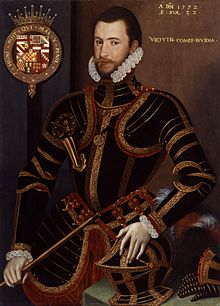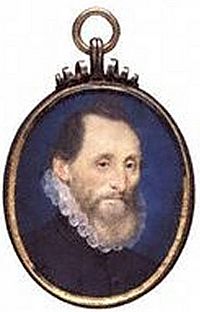George Carleton (MP) facts for kids
Quick facts for kids
George Carleton
|
|
|---|---|
| Born | 1529 |
| Died | January 1590 (aged 60–61) |
| Spouse(s) |
|
| Issue |
|
| Father | John Carleton |
| Mother | Joyce Welbeck |
George Carleton (born in 1529, died in January 1590) was an English lawyer and a large landowner. He also served as a Member of Parliament, which means he was elected to help make laws for the country. He was known for his strong Puritan beliefs. Puritans were a group of Protestants who wanted to make the Church of England simpler and more "pure."
Some people think George Carleton secretly wrote the Marprelate tracts. These were a series of pamphlets that criticized the bishops and the way the Church of England was run. Both he and his third wife faced legal trouble because of their connection to these writings. He was ordered to appear before the Queen's special council in April 1589, but he died in early 1590 before his case was finished.
Contents
Who Was George Carleton?
George Carleton was born in 1529. He was the second son of John Carleton and Joyce Welbeck. His father owned land in Walton-on-Thames, Surrey, and Brightwell Baldwin, Oxfordshire. His mother's grandmother, Margaret Culpeper, was the aunt of King Henry VIII's fifth wife, Katherine Howard.
George had four brothers and four sisters. His brother Anthony Carleton was the grandfather of a famous diplomat named Dudley Carleton, 1st Viscount Dorchester.
George Carleton's Career

George Carleton's father worked for the Abbot of Westminster, who was an important church leader. Because of this connection, George received a scholarship to study at Christ Church, Oxford. In 1552, he joined Gray's Inn, which was a place where lawyers were trained. He used his legal skills to help his friends and family, often managing their money and legal matters.
He also served in the military twice. In 1557, he was a captain during a battle called St Quentin. In 1573, he was the treasurer for the Earl of Essex's trip to Ireland.
Over time, George Carleton became a very wealthy landowner. He inherited land from his father and also bought a lot more. He owned land in several counties, including Oxfordshire, Northamptonshire, and Gloucestershire. He also bought large areas of marshland in the fens, which are low, wet areas. He was one of the first people to use windmills to drain these marshlands, making them useful for grazing animals. He also helped manage water systems in the fens.
He served as a Justice of the Peace (a local judge) in several areas. He was also elected as a Member of Parliament for Poole in 1571 and for Dorchester in 1572, 1576, and 1581. He was even in charge of watching over Jesuits and other Catholics who were held in Wisbech Castle.
Puritan Beliefs and the Marprelate Tracts

George Carleton was a very strong Puritan. He believed that only Puritans were truly loyal to Queen Elizabeth I. He even suggested that the Queen's Catholic subjects should be moved to new settlements in Ireland. He also proposed creating a special army made up mostly of religious people to protect the Queen.
He supported Puritan preachers and even invited them to give sermons at his home. In Parliament, he worked hard to bring about more religious changes that followed Puritan ideas.
Carleton's strong Puritan views led him to get involved with the Marprelate tracts during the last year of his life. These tracts were secret pamphlets that criticized the Church of England's bishops. In 1589, he married Elizabeth Hussey, who was also known as 'Mistress Crane'. The first of the Marprelate tracts was printed at her country home in East Molesey in October 1588.
After the first tract was printed, the secret printing press was moved to other locations, including the home of Sir Richard Knightley, a friend of Carleton's. More tracts were printed there and at other places. Even though the secret press wasn't found until August 1589, George Carleton was already ordered to appear before the Queen's special council in April 1589. He had to attend daily meetings.
Carleton died in early January 1590 before any final decision was made in his case. His wife was later sent to prison and had to pay a large fine because of her involvement. Some historians believe that George Carleton might have been the secret author of the Marprelate tracts himself.
Family Life
George Carleton was married three times.
His first marriage was in 1559 to Audrey Gainsford. She had been married twice before. She died in early 1560. They did not have any children together.
His second marriage was in 1561 to Elizabeth Mohun. She was the widow of Edward Cope. With Elizabeth, George had a son named Castle Carleton and a daughter named Elizabeth Carleton.
His third marriage was to Elizabeth Hussey. Her father was Sir Robert Hussey. Elizabeth's grandfather, William Hussey, was a very important judge. George and Elizabeth did not have any children together.

